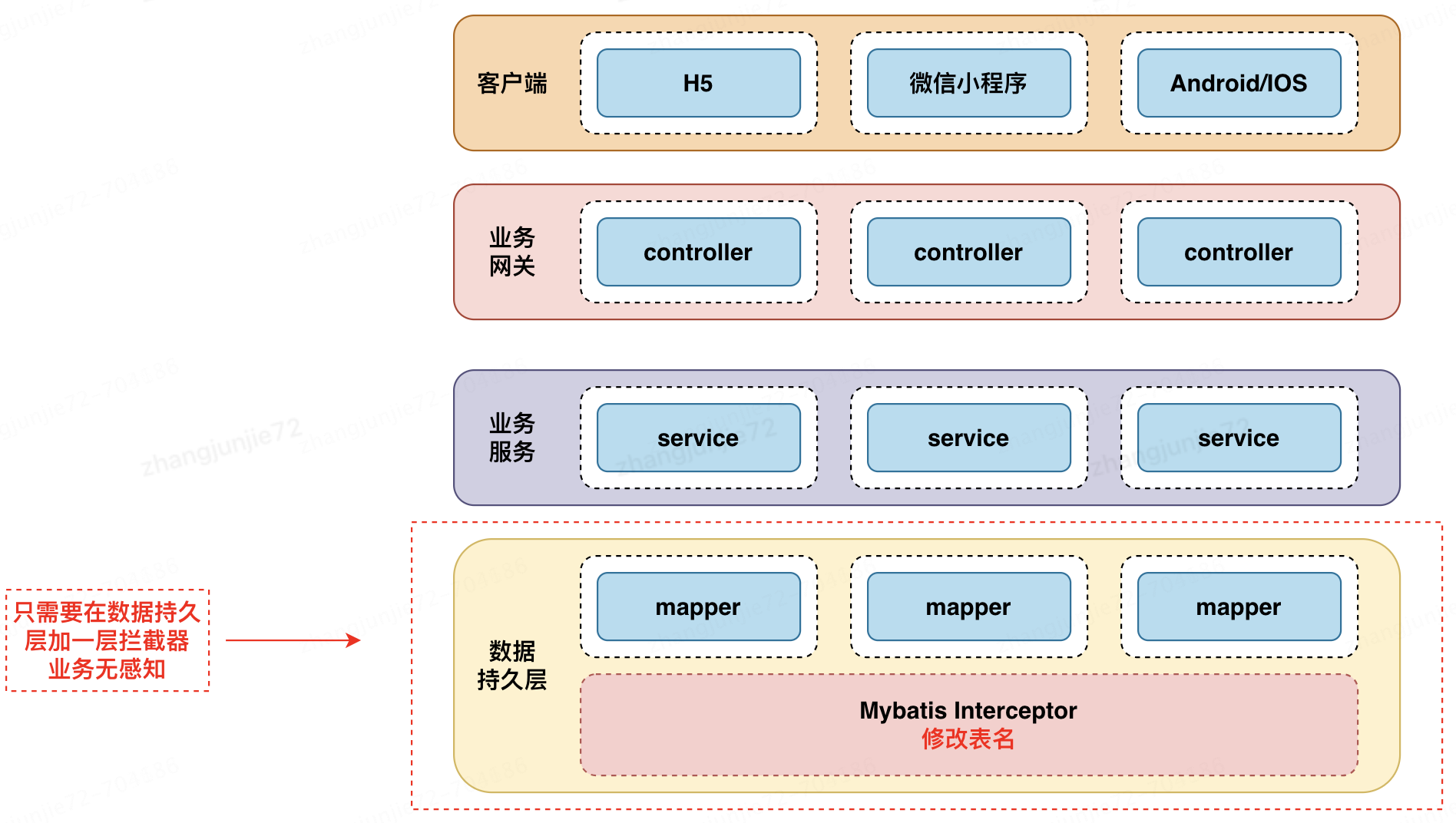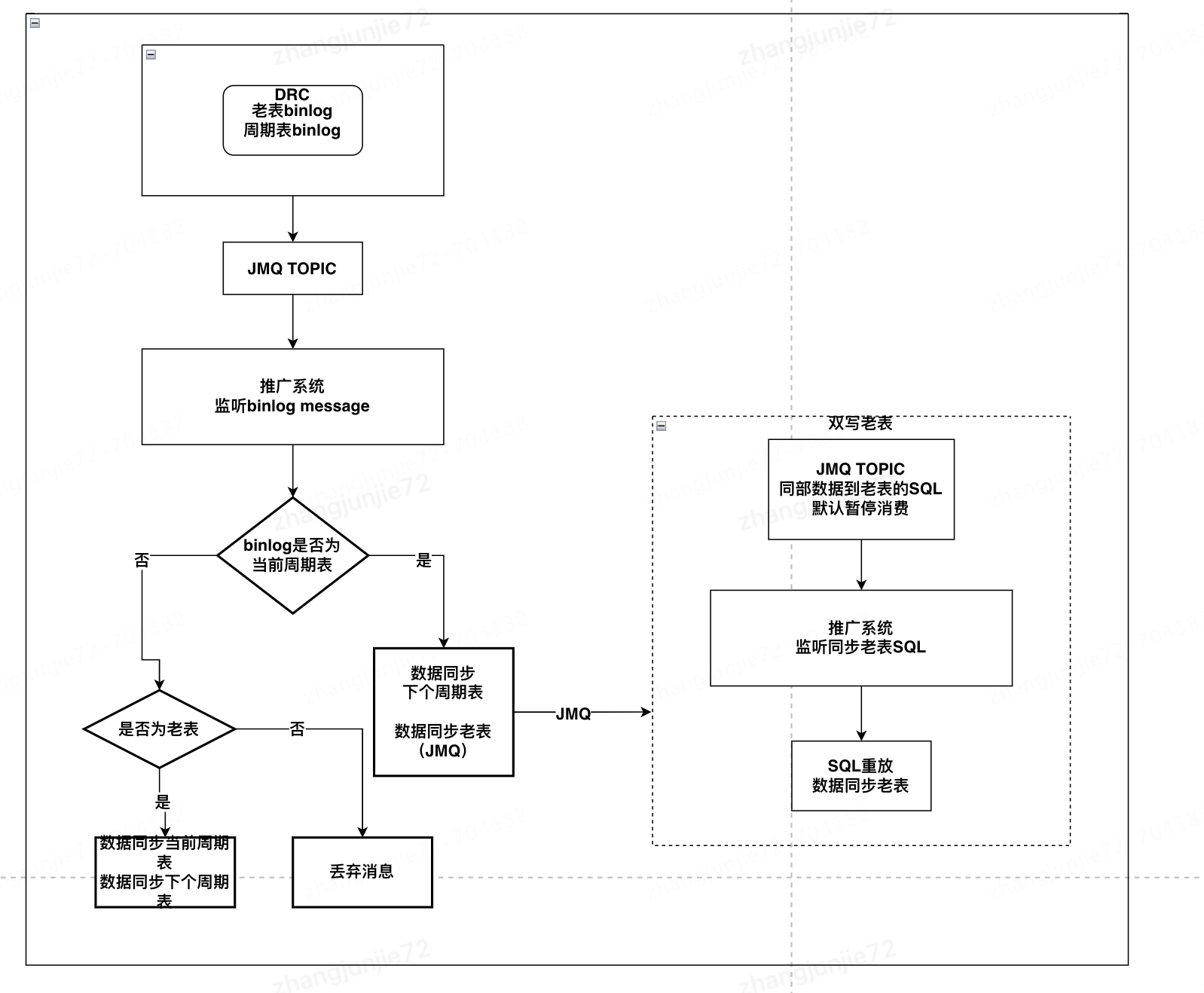一种轻量分表方案-MyBatis拦截器分表实践
背景
部门内有一些亿级别核心业务表增速非常快,增量日均100W,但线上业务只依赖近一周的数据。随着数据量的迅速增长,慢SQL频发,数据库性能下降,系统稳定性受到严重影响。本篇文章,将分享如何使用MyBatis拦截器低成本的提升数据库稳定性。
业界常见方案
针对冷数据多的大表,常用的策略有以2种:
1. 删除/归档旧数据。
2. 分表。
归档/删除旧数据
定期将冷数据移动到归档表或者冷存储中,或定期对表进行删除,以减少表的大小。此策略逻辑简单,只需要编写一个JOB定期执行SQL删除数据。我们开始也是用这种方案,但此方案也有一些副作用:
综上,此方案有一定风险,为了规避这种风险,我们决定采用另一种方案:分表。
分表
我们决定按日期对表进行横向拆分,实现让系统每周生成一张周期表,表内只存近一周的数据,规避单表过大带来的风险。
分表方案选型
经调研,考虑2种分表方案:Sharding-JDBC、利用Mybatis自带的拦截器特性。
经过对比后,决定采用Mybatis拦截器来实现分表,原因如下:

分表具体实现代码
分表配置对象
import lombok.AllArgsConstructor;
import lombok.Data;
import lombok.NoArgsConstructor;
import java.util.Date;
@Data
@AllArgsConstructor
@NoArgsConstructor
public class ShardingProperty {
// 分表周期天数,配置7,就是一周一分
private Integer days;
// 分表开始日期,需要用这个日期计算周期表名
private Date beginDate;
// 需要分表的表名
private String tableName;
}
分表配置类
import java.util.concurrent.ConcurrentHashMap;
public class ShardingPropertyConfig {
public static final ConcurrentHashMap<String, ShardingProperty> SHARDING_TABLE ();
static {
ShardingProperty orderInfoShardingConfig = new ShardingProperty(15, DateUtils.string2Date("20231117"), "order_info");
ShardingProperty userInfoShardingConfig = new ShardingProperty(7, DateUtils.string2Date("20231117"), "user_info");
SHARDING_TABLE.put(orderInfoShardingConfig.getTableName(), orderInfoShardingConfig);
SHARDING_TABLE.put(userInfoShardingConfig.getTableName(), userInfoShardingConfig);
}
}
拦截器
import lombok.extern.slf4j.Slf4j;
import o2o.aspect.platform.function.template.service.TemplateMatchService;
import org.apache.commons.lang3.StringUtils;
import org.apache.ibatis.executor.statement.StatementHandler;
import org.apache.ibatis.mapping.BoundSql;
import org.apache.ibatis.mapping.MappedStatement;
import org.apache.ibatis.plugin.*;
import org.apache.ibatis.reflection.DefaultReflectorFactory;
import org.apache.ibatis.reflection.MetaObject;
import org.apache.ibatis.reflection.ReflectorFactory;
import org.apache.ibatis.reflection.factory.DefaultObjectFactory;
import org.apache.ibatis.reflection.factory.ObjectFactory;
import org.apache.ibatis.reflection.wrapper.DefaultObjectWrapperFactory;
import org.apache.ibatis.reflection.wrapper.ObjectWrapperFactory;
import org.springframework.stereotype.Component;
import java.sql.Connection;
import java.time.LocalDateTime;
import java.time.format.DateTimeFormatter;
import java.util.Date;
import java.util.Properties;
@Slf4j
@Component
@Intercepts({@Signature(type = StatementHandler.class, method = "prepare", args = {Connection.class, Integer.class})})
public class ShardingTableInterceptor implements Interceptor {
private static final ObjectFactory DEFAULT_OBJECT_FACTORY = new DefaultObjectFactory();
private static final ObjectWrapperFactory DEFAULT_OBJECT_WRAPPER_FACTORY = new DefaultObjectWrapperFactory();
private static final ReflectorFactory DEFAULT_REFLECTOR_FACTORY = new DefaultReflectorFactory();
private static final String MAPPED_STATEMENT = "delegate.mappedStatement";
private static final String BOUND_SQL = "delegate.boundSql";
private static final String ORIGIN_BOUND_SQL = "delegate.boundSql.sql";
private static final DateTimeFormatter FORMATTER = DateTimeFormatter.ofPattern("yyyyMMdd");
private static final String SHARDING_MAPPER = "com.jd.o2o.inviter.promote.mapper.ShardingMapper";
private ConfigUtils configUtils = SpringContextHolder.getBean(ConfigUtils.class);
@Override
public Object intercept(Invocation invocation) throws Throwable {
boolean shardingSwitch = configUtils.getBool("sharding_switch", false);
// 没开启分表 直接返回老数据
if (!shardingSwitch) {
return invocation.proceed();
}
StatementHandler statementHandler = (StatementHandler) invocation.getTarget();
MetaObject metaStatementHandler = MetaObject.forObject(statementHandler, DEFAULT_OBJECT_FACTORY, DEFAULT_OBJECT_WRAPPER_FACTORY, DEFAULT_REFLECTOR_FACTORY);
MappedStatement mappedStatement = (MappedStatement) metaStatementHandler.getValue(MAPPED_STATEMENT);
BoundSql boundSql = (BoundSql) metaStatementHandler.getValue(BOUND_SQL);
String originSql = (String) metaStatementHandler.getValue(ORIGIN_BOUND_SQL);
if (StringUtils.isBlank(originSql)) {
return invocation.proceed();
}
// 获取表名
String tableName = TemplateMatchService.matchTableName(boundSql.getSql().trim());
ShardingProperty shardingProperty = ShardingPropertyConfig.SHARDING_TABLE.get(tableName);
if (shardingProperty == null) {
return invocation.proceed();
}
// 新表
String shardingTable = getCurrentShardingTable(shardingProperty, new Date());
String rebuildSql = boundSql.getSql().replace(shardingProperty.getTableName(), shardingTable);
metaStatementHandler.setValue(ORIGIN_BOUND_SQL, rebuildSql);
if (log.isDebugEnabled()) {
log.info("rebuildSQL -> {}", rebuildSql);
}
return invocation.proceed();
}
@Override
public Object plugin(Object target) {
if (target instanceof StatementHandler) {
return Plugin.wrap(target, this);
}
return target;
}
@Override
public void setProperties(Properties properties) {}
public static String getCurrentShardingTable(ShardingProperty shardingProperty, Date createTime) {
String tableName = shardingProperty.getTableName();
Integer days = shardingProperty.getDays();
Date beginDate = shardingProperty.getBeginDate();
Date date;
if (createTime == null) {
date = new Date();
} else {
date = createTime;
}
if (date.before(beginDate)) {
return null;
}
LocalDateTime targetDate = SimpleDateFormatUtils.convertDateToLocalDateTime(date);
LocalDateTime startDate = SimpleDateFormatUtils.convertDateToLocalDateTime(beginDate);
LocalDateTime intervalStartDate = DateIntervalChecker.getIntervalStartDate(targetDate, startDate, days);
LocalDateTime intervalEndDate = intervalStartDate.plusDays(days - 1);
return tableName + "_" + intervalStartDate.format(FORMATTER) + "_" + intervalEndDate.format(FORMATTER);
}
}
临界点数据不连续问题
分表方案有1个难点需要解决:周期临界点数据不连续。举例:假设要对operate_log(操作日志表)大表进行横向分表,每周一张表,分表明细可看下面表格。
| 第一周(operate_log_20240107_20240108) | 第二周(operate_log_20240108_20240114) | 第三周(operate_log_20240115_20240121) |
| 1月1号 ~ 1月7号的数据 | 1月8号 ~ 1月14号的数据 | 1月15号 ~ 1月21号的数据 |
1月8号就是分表临界点,8号需要切换到第二周的表,但8号0点刚切换的时候,表内没有任何数据,这时如果业务需要查近一周的操作日志是查不到的,这样就会引发线上问题。
我决定采用数据冗余的方式来解决这个痛点。每个周期表都冗余一份上个周期的数据,用双倍数据量实现数据滑动的效果,效果见下面表格。
| 第一周(operate_log_20240107_20240108) | 第二周(operate_log_20240108_20240114) | 第三周(operate_log_20240115_20240121) |
| 12月25号 ~ 12月31号的数据 | 1月1号 ~ 1月7号的数据 | 1月8号 ~ 1月14号的数据 |
| 1月1号 ~ 1月7号的数据 | 1月8号 ~ 1月14号的数据 | 1月15号 ~ 1月21号的数据 |
注:表格内第一行数据就是冗余的上个周期表的数据。
思路有了,接下来就要考虑怎么实现双写(数据冗余到下个周期表),有2种方案:
方案对比后,选择了对业务性能损耗小的方案二。
监听binlog并双写流程图

监听binlog数据双写注意点
监听binlog数据双写代码
注:下面代码不能直接用,只提供基本思路
/**
* 监听binlog ,分表双写,解决数据临界问题
*/
@Slf4j
@Component
public class BinLogConsumer implements MessageListener {
private MessageDeserialize deserialize = new JMQMessageDeserialize();
private static final String TABLE_PLACEHOLDER = "%TABLE%";
@Value("${mq.doubleWriteTopic.topic}")
private String doubleWriteTopic;
@Autowired
private JmqProducerService jmqProducerService;
@Override
public void onMessage(List<Message> messages) throws Exception {
if (messages == null || messages.isEmpty()) {
return;
}
List<EntryMessage> entryMessages = deserialize.deserialize(messages);
for (EntryMessage entryMessage : entryMessages) {
try {
syncData(entryMessage);
} catch (Exception e) {
log.error("sharding sync data error", e);
throw e;
}
}
}
private void syncData(EntryMessage entryMessage) throws JMQException {
// 根据binlog内的表名,获取需要同步的表
// 3种情况:
// 1、老表:需要同步当前周期表,和下个周期表。
// 2、当前周期表:需要同步下个周期表,和老表。
// 3、下个周期表:不需要同步。
List<String> syncTables = getSyncTables(entryMessage.tableName, entryMessage.createTime);
if (CollectionUtils.isEmpty(syncTables)) {
log.info("table {} is not need sync", tableName);
return;
}
if (entryMessage.getHeader().getEventType() == WaveEntry.EventType.INSERT) {
String insertTableSqlTemplate = parseSqlForInsert(rowData);
for (String syncTable : syncTables) {
String insertSql = insertTableSqlTemplate.replaceAll(TABLE_PLACEHOLDER, syncTable);
// 双写老表发Q,为了避免出现同步死循环问题
if (ShardingPropertyConfig.SHARDING_TABLE.containsKey(syncTable)) {
Long primaryKey = getPrimaryKey(rowData.getAfterColumnsList());
sendDoubleWriteMsg(insertSql, primaryKey);
continue;
}
mysqlConnection.executeSql(insertSql);
}
continue;
}
}
数据对比
为了保证新表和老表数据一致,需要编写对比程序,在上线前进行数据对比,保证binlog同步无问题。
具体实现代码不做展示,思路:新表查询一定量级数据,老表查询相同量级数据,都转换成JSON,equals对比。
作者:京东零售 张均杰
来源:京东云开发者社区 转载请注明来源
一种轻量分表方案-MyBatis拦截器分表实践的更多相关文章
- 基于mybatis拦截器分表实现
1.拦截器简介 MyBatis提供了一种插件(plugin)的功能,但其实这是拦截器功能.基于这个拦截器我们可以选择在这些被拦截的方法执行前后加上某些逻辑或者在执行这些被拦截的方法时执行自己的逻辑. ...
- 玩转SpringBoot之整合Mybatis拦截器对数据库水平分表
利用Mybatis拦截器对数据库水平分表 需求描述 当数据量比较多时,放在一个表中的时候会影响查询效率:或者数据的时效性只是当月有效的时候:这时我们就会涉及到数据库的分表操作了.当然,你也可以使用比较 ...
- PintJS – 轻量,并发的 GruntJS 运行器
PintJS 是一个小型.异步的 GruntJS 运行器,试图解决大规模构建流程中的一些问题. 典型的Gruntfile 会包括 jsHint,jasmine,LESS,handlebars, ugl ...
- Mybatis拦截器介绍
拦截器的一个作用就是我们可以拦截某些方法的调用,我们可以选择在这些被拦截的方法执行前后加上某些逻辑,也可以在执行这些被拦截的方法时执行自己的逻辑而不再执行被拦截的方法.Mybatis拦截器设计的一个初 ...
- Mybatis拦截器介绍及分页插件
1.1 目录 1.1 目录 1.2 前言 1.3 Interceptor接口 1.4 注册拦截器 1.5 Mybatis可拦截的方法 1.6 利用拦截器进行分页 1.2 前言 拦截器的一 ...
- Mybatis拦截器执行过程解析
上一篇文章 Mybatis拦截器之数据加密解密 介绍了 Mybatis 拦截器的简单使用,这篇文章将透彻的分析 Mybatis 是怎样发现拦截器以及调用拦截器的 intercept 方法的 小伙伴先按 ...
- "犯罪心理"解读Mybatis拦截器
原文链接:"犯罪心理"解读Mybatis拦截器 Mybatis拦截器执行过程解析 文章写过之后,我觉得 "Mybatis 拦截器案件"背后一定还隐藏着某种设计动 ...
- 关于mybatis拦截器,对结果集进行拦截
因业务需要,需将结果集序列化为json返回,于是,网上找了好久资料,都是关于拦截参数的处理,拦截Sql语法构建的处理,就是很少关于对拦截结果集的处理,于是自己简单的写了一个对结果集的处理, 记录下. ...
- 详解Mybatis拦截器(从使用到源码)
详解Mybatis拦截器(从使用到源码) MyBatis提供了一种插件(plugin)的功能,虽然叫做插件,但其实这是拦截器功能. 本文从配置到源码进行分析. 一.拦截器介绍 MyBatis 允许你在 ...
- Mybatis拦截器,修改Date类型数据。设置毫秒为0
1:背景 Mysql自动将datetime类型的毫秒数四舍五入,比如代码中传入的Date类型的数据值为 2021.03.31 23:59:59.700 到数据库 2021.04.01 0 ...
随机推荐
- 没想到,学棋五年的我竟然输给了昇腾CANN!
摘要:整整两天,上百场对弈,TA竟然未尝一败,真是让人拍案叫绝. 近日,一位神秘"人物"亮相华为昇腾CANN技术开放日现场,引得众人簇拥,吸粉无数.从现场AI棋艺大战的画面中我们可 ...
- storybook添加全局样式与sass全局变量设置
storybook组件需要全局样式,只需在.storybook/preview.js 增加全局样式即可. import '../src/style/index.scss'; export const ...
- 新一代构建工具(1):对比rollup/parcel/esbuild—esbuild脱颖而出
文章内容来源: 字节前端是如何基于 ESBuild 的做现代化打包设计? https://mp.weixin.qq.com/s/bS_qwiOIMqFN1sfuPKTUbA 新世代建置工具解析(esb ...
- MongoDB 副本模式,会映射到本地 127.0.0.1 错误
基于 MongoDB 读写分离--Windows MongoDB 副本集配置 ,里面配置了一个坑,导致出现下列错误 [2021-05-10 10:06:11.981] [cluster-Cluster ...
- 初识QT、窗口以及信号槽
1 基本规范: 无论是写什么样的代码,第一步都应该是创建一个程序对象 #include <QApplication> int main(int argc, char *argv[]) { ...
- C223 生产版本BAPI
1.事务代码:C223 2.调用函数CM_FV_PROD_VERS_DB_UPDATE "-----------------------------@斌将军----------------- ...
- 【计算机网络】身份认证Oauth2
身份认证Oauth2 https://www.bilibili.com/video/BV1FL411h7es/?spm_id_from=333.999.0.0&vd_source=d11276 ...
- JS 闭包 BUG
C.js代码: /** * 有BUG */ (function (global) { var _id; var _map; var _length; global.C = function () { ...
- Java 21 新特性:Unnamed Patterns and Variables
Java 21中除了推出JEP 445:Unnamed Classes and Instance Main Methods之外,还有另外一个预览功能:未命名模式和变量(Unnamed Patterns ...
- 一、mysql5.7 rpm 安装(单机)
一.下载需要的rpm包mysql-community-client-5.7.26-1.el6.x86_64.rpmmysql-community-common-5.7.26-1.el6.x86_64. ...
